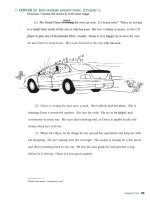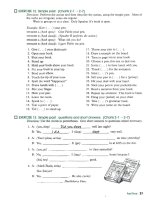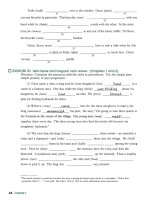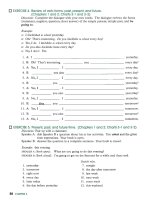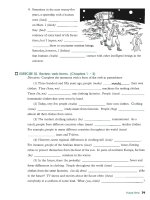Fundamentals of english grammar third edition part 25 pptx
Bạn đang xem bản rút gọn của tài liệu. Xem và tải ngay bản đầy đủ của tài liệu tại đây (436.18 KB, 7 trang )
CONTENTS
6-1
Pronunciation of final
4-es
6-10
Personal pronouns: subjects and objects
6-2
Plural forms of nouns
6-1
1
Possessive nouns
6-3
Subjects, verbs, and objects
6-12
Possessive pronouns and adjectives
6-4
Objects of prepositions
6- 13
Reflexive pronouns
6-5
Prepositions of time
6-14
Singular forms of
other: another
vs.
6-6
Word order: place and time
the other
6-7
Subject-verb agreement
6-15
Plural forms of
other: other(s)
vs.
the
6-8
Using adjectives to describe nouns
other(s)
6-9
Using nouns as adjectives
6-1
6
Summary of forms of
other
.,
z,
,,,
EXERCISE
1.
Prevlew: grammar terms. (Chapter
6)
Directions:
This exercise previews grammar terms used in this chapter. Identify the
italicized
word in each sentence as a
NOUN,
ADJECTIVE,
PREPOS~ON,
or
PRONOUN.
1.
Eric is wearing a new
shirt
today.
2.
Algeria is
in
North Africa.
3.
Steve is in Asia.
He
is traveling.
4.
I'm
thirs~y.
5.
We have class
in
this
mom
every day.
6.
I
know my
way
to Joanna's house.
7.
The
ham
children squealed with joy.
8.
I
walked to class
with
Maria.
9.
Hawaii has eight principal
islands.
10.
The
hungry
man
stufFed his mouth
with
rice.
1 1.
Tokyo is the capital of
Japan.
12.
Athens is a
beaueiful
city.
13.
My history book is
under
my desk.
14.
Do
you Wre classical
music?
15.
I can't find my keys. Have you seen
them?
1w
*.r
;
shirt
how
in
~ve~odtioh
he
PVORO~AR
thirsty
~~ec+iv~
room
way
haPm
with
islands
hungry
Japan
beauttw
under
music
them
1
6-1
PRONUNCIATION
OF
FINAL
-SI-ES
I
Final
-61-es has three different pronunciations: Isl,
Id,
and lad.
(b)
seeds
=
seedd
Id is the sound of
"z"
in
"buzz."
Final
-8
is
pronounced
Id
after voiced
srm
=
starld
sounds. Examples of voiced* sounds: Id, Irl, IU, /mi, hl, and all vowel
holes
=
hole/z/ sounds.
laws
=
lnwld
(c) dishes
3
dishlad lad adds a whole syllable to a word.
Fi
-61-ea is pronounced lad
matches
3
matchlad
after
-&
-ch,
-s,
-z,
-&?elk&- munds.
classes
=
classlad
sizes
3
sizelad
pages
=
pagelad
judges
=
judgelad
*See
Chart
2-4,
p.
28,
for more infomtion
about
voiceless and voiced sounds.
(a) seats
=
seatlsl
maps
=
maplsl
lakes
=
lake/d
EXERCISE
2.
Pronunclotion of final 41-ES. (Chart
6-1)
Directions:
Write the correct pronunciations and practice saying the words.
Id is the sound of
"s"
in "bus." Final
4
is pronounced la1 after voiceless
sounds. Examples of voiceless* sounds:
Id,
Ipl,
Id.
1.
names
=
name1
r
I
8.
hills
=
hilY
/
14.
glasses
=
glass1
I
2.
clocks
=
clock/
s
I
9.
cars
=
cad
I
15.
prices
=
price/ 1
3.
eyes
=
eye/
I
10.
ways
=
way/
/
16. prizes
=
prize/ I
4.
heads
=
head
/
1
1.
months
=
month1
/
17.
faxes
=
fax/ I
5.
boats
=
boat1
I
12. eyelashes
=
eyelash/
I
18. bridges
=
bridge/
1
6. ribs
=
rib/
I
13.
itches
=
itch/ 1
19.
cages
=
cage1
/
7.
lips
=
lip/ I
EXERCISE
3.
Preview: plural nouns. (Chart
6-2)
Directions:
These sentences have many mistakes
in
the use of nouns.
Underline
each
noun. Write the correct plural form
if
necessary. Do not change any of the other words
in
the sentences.
streets
highways
-
1.Chicapohasbusy-and*.
5.
Insect don't have nose.
.Aq,
2.
Box have six side.
3.
Big city have many problem.
4.
Banana grow in hot, humid area.
6. Lamb are the offspring of sheep.
7.
Library keep book on shelf.
8.
Parent support their child.
Nouna ond Pronouns
157
9,
Indonesia has several active volcano.
10.
Baboon are big monkey. They have large head
and
sharp tooth. They eat leaf, root, insect, and egg.
-2
PLURAL
FORMS OF NOUNS
SINGULAR
PLURAL
(a) one bud two
birdr
one street two
streets
one rose two
roses
(b)
one dish two
&he8
one match two
mtchss
one class two
classes
one box two
boxes
(c) one baby two
babies
one city two
cities
(d) one toy two
toys
one key two
keys
(e)
one knife two
knives
one shelf two
shelvss
(f)
one tomato two
tomcrtoos
one zoo
.,
two
BOOS
one zero two
zemes/z8+08
'I
(g)
one child two
children
one foot two
feet
one goose two
geese
one man two
men
one mouse two
mice
one tooth two
teeth
one
woman
two
w~11~n
two
people
(h)
one deer two
deer
one fish two
fish
one sheep two
sheep
one offspring two
Q&W.ng
one soecies
two
~cies
(i) one bacterium
two
bacto*irr
one cams two
cacti
one crisis two
crises
one phenomenon two
phenomena
To make most nouns plural, add
-s.
Add
-es
to nouns endiing in
-sh, -ch, -ss,
and
-x.
If a noun ends in a consonant
+
-y,
change they to
8'
and
add
-es,
as
in
(c).
If
-y
is preceded by a vowel, add only
-s,
as in (d).
If a noun ends
in
-fe
or
-f,
change the endiing to
-ws.
(Exceptions:
beliefs, chief, roof,
cuffs, dsffs.)
The plural form of nouns that end in
-0
is sometimes
-ws
and sometimes
-0s.
-oes:
wmawes,potaroes, hemer,
echoes
-0s:
zoos, radios, studios, pianos, solos, sopmnos, photos, auws,
videos
-ws
or
-0s:
zeroes zeros; mlcanoes volcaolcanos,
wrnadoes/wrnados, mosquiwesrmosquiws
Some nouns have irregular plural forms.
(Note: The singular form of
people
can be
persun, woman,
man, child.
For example, one man and one child
=
two
people.)
The plural form of some nouns is the same as the
singular
form.
Some nouns that English has borrowed from other
languages have foreign plurals.
I7
EXERCISE
4.
Plural
nouns.
(Chart
6-2)
Directions:
Write the plural forms of the nouns.
1.
one potato, two
~Otfitoes
2.
a library, many
3.
one child, two
4.
a leaf, a lot of
5.
a wish, many
6.
one fish, two
7.
an opinion, many
8.
a mouse, several
9.
a sandwich, some
10.
a man, many
11.
one woman, two
12.
a flash, three
13.
one tomato, a few
-,
14.
one tooth, two
15.
one half, two
16.
a tax, a lot of
17.
a possibility, several
18.
a thief, many
19.
a hero, many
20.
a goose, a lot of
21.
an attorney, a few
22.
a butterfly, several
23.
one category, two
24.
a mosquito, a lot of
25.
one sheep, two
26.
a wolf, some
27.
one stitch, two
28.
one foot, three
29.
one piano, two
30.
a belief, many
6-3
SUBJECTS, VERBS,
AND
OBJECTS
L
-
8
v
0
(c)
PPIlntd
need
water,
(noun) (verb) (noun)
s
v
0
(d)
~ob
is
reading
a
book.
(noun) (verb) (noun)
r
AnEnglish sentence
has
a
SUBJECT
(s) and
a
VsRB
(v).
The
SUBJECT
is
a
noun.
In
(a):
sun
is
a
noun;
it is
the
subject of the
verb
shines.
Sometimes
a
VERB
is followed
by
an
OBJECT
(0).
I
The
OBJBCT
of
a
verb is
a
noun.
In (c):
water
is
the
object
of
the verb
need.
Nouns
and
Pronouns
159
EXERCISE
5.
Subjects, verbs, and objects. (Chart 6-3)
,
"
Directions:
Identify the subject
(s)
and verb
(v)
of each sentence. Also hd the object
(0)
of the verb
if
the sentence has an object.
i'.
S
V
0
1.
The carpenter built a table.
s
v
2.
Birds fly.
.~lV
e
.
'
3.
Cows eat grass.
C,: ,l
.:/ .
4.
My dog barked.
5.
The dog chased the cat.
8.
Most birds build nests.
9.
Our
guests arrived.
10.
Teachers assign homework.
1 1.
My
roommate opened the window.
12.
Jack raised his hand.
13.
Irene
6.
Steam rises.
7.
Accidents happen.
-
'r,y,,-,P
.i:,,.
.
:!
is watching her sister's
.',.
.><I;<?!.?
'
. ,
i
:!
.
L,.
i
,:.
>
b
:~'
.
.
,.smo.,J
.?.I?
I
!
children.
.,
-
I.
'Ii
.I
I3
EXERCISE
6.
Nouns and
verbs.
(Charts 6-2 and 6-3)
Directions:
Some words can be used both as a noun and as a verb.
If
the word in
italics
is
used as a noun, circle
n.
If
the word in
italics
is used as a verb, circle
v.
(n.
=
noun
and
v.
=
verb)
People
smile
when they're happy.
Mary has a nice
smile
when she's happy.
Emilv does good
work.
-
Emily and Mike
wmk
at the cafeterim'
People usually
store
milk in the refrigerator.
We went to the
store
to buy some milk.
es
1
The child wkte her
name
on the wall with a crayon.
People often
name
their children after relatives.
Airplanes
land
on runways at the airport.
The ship reached
land
after seventeen days at sea.
I
took a
main
from NewYork to Boston last week.
I
main
my dogs to sit on command.
jt,
Alex
visiu
his aunt wery week.
Alex's aunt enjoys his
visirs
every week.
EXERCISE
7.
Nouns and
verbs.
(Charts
6-2
and
6-3)
Directions:
Use each word in
two
different sentences. Use the word as a noun
(n.)
in the
first sentence and as a verb
(v.)
in the second sentence. Consult your dictionary if
necessary to find out the different uses and meanings of a word.
Example:
watch
+
n.
I
am wearing a
watch.
v.
I
watched
TV
afm dinner
last
night.
1.
rain
4.
phone
7.
water
2.
paint
5.
shop
.
8.
circle
3.
tie
6.
face
9.
fly
Other common words that
are
used as both nouns and verbs are listed below. Choose
several from the list to make additional sentences. Use your dictionary if necessary.
centerlcentre*
garden question snow
date
mail rock star
experience mind
season tip
e-mail place
sense trip
fear
plant shape value
fish
promise smoke
1
6-4
OBJECTS OF PREPOSITIONS
I
S
V
0
PREP
OOFPRKP
(a)
Ann
put her books
on
the
dark.
(noun)
S
v
PRBP
OOPPRHP
(b)
A
leaf feu
to
the
ground.
(noun)
REPERENCE
LIST
OF
PREPOSITIONS
Many English sentences have prepositional phrases. In
(a):
on
the
desk
is a prepositional phrase.
A
prepositional phrase consists of a PReposrnoN
(PREP)
and
an
OBJEC~
OF
A
PREPOS~~ON
(O
OF
PREP).
The
object of a preposition is
a
NOUN.
about
abm
mss
afrPr
againrt
hng
among
around
Of
before
behind
below
beneath
beside
besides
between
beyond
by
dapite
dm
during
for
fmm
in
inw
like
near
<.!
.:,
,
of
"
.,;.
.;
"
8.
:
on
,:+
.
out
over
since
through
throughout
ti[l
.
<.
to
-rd(sl
under
until
UP
urn
with
within
without
'American
Bnglish:
mut;
Brirish
English:
unm.
Nouns and Pronouns
161
EXERCISE
8.
Subjects, verbs, and objects. (Charts
6-3
and
6-4)
Directions:
Identify the subjects, verbs, and objects. Also identify the preposition
(PREP)
and the noun that is used as the object of the preposition
(0
OF
PREP).
s
v
o
PREP
o
cF
PREP
1.
Sara saw a picture on the wall.
2.
Sara looked at the pictures.
3.
Emily waited for her friend at a restaurant.
4.
The sun rises in the east.
5.
Sue lost her ring
in
the sand at the beach.
6.
The moon usually disappears from view during the day.
7.
Eric talked to his friend on the phone for
thirty
minutes.
8.
Children
throughout the world play with dolls.
9.
Astronauts walked on the moon
in
1969.
10.
A
woman
in a blue suit sat beside me until the end of the meeting.
tCISE
9.
Preposltlons of place. (Chart
6-4)
DirecFMnc
Review prepositions of place* by
using
the following phrases
in
sentences.
Demonstrate the meaning of the preposition by some action.
Work
in
pairs,
in
small
groups, or as a class.
Ezample:
above my head
-r
I'm
holding
my
hand
abwe
my
head.
(The speaker demonstrates this action.)
1.
across the room
2.
against the wall
1 1.
below the window
12.
beside my book
3.
among my books and papers
13.
near the door
4.
between two pages of my book
14.
far from the door
5.
around my wrist
15.
off my desk
6.
at my desk
16.
out the window
7.
on my desk
8.
in the room
9.
into the room
10.
behind me
17.
under my desk
18.
through the door
19.
throughout the room
20.
toward($ the door
'Repositions
of place
BIT
also called "prepositions of location."
162
CHAPlER6



